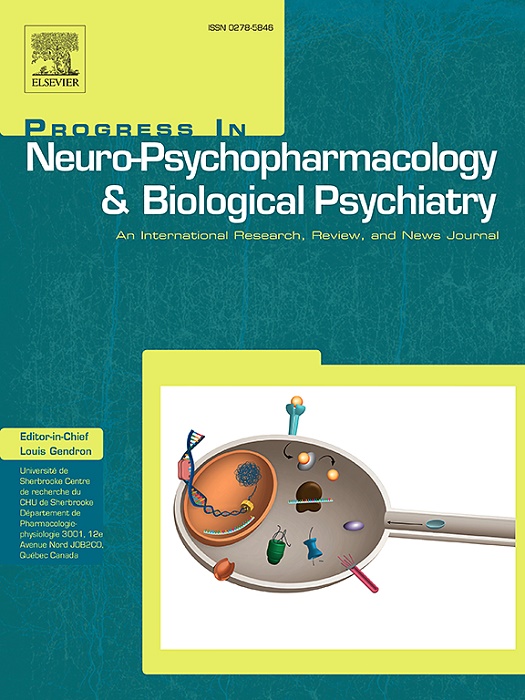Kynurenine amplifies tetrahydrocannabinol-induced sensorimotor impairment and classic “tetrad” effects in mice
IF 5.3
2区 医学
Q1 CLINICAL NEUROLOGY
Progress in Neuro-Psychopharmacology & Biological Psychiatry
Pub Date : 2025-03-24
DOI:10.1016/j.pnpbp.2025.111342
引用次数: 0
Abstract
Background
L-kynurenine (KYN), a kynurenine pathway (KP) metabolite, is the main precursor for the neuroactive metabolite kynurenic acid (KYNA). Several studies suggest a patho-physiologically relevant association between increased brain KYNA levels and cognitive dysfunctions in individuals with schizophrenia. Δ9-tetrahydrocannabinol (Δ9-THC; i.e. the main psychoactive compound of cannabis) can worse schizophrenia-related psychosis, often leads to the development of cannabis use disorder in individuals with schizophrenia, and increases the risk of earlier onset of schizophrenia symptoms in those with a genetic predisposition. A role of KP alterations and, specifically, increased brain KYNA levels in Δ9-THC-induced psychotic symptoms has been previously proposed. The aim of the study was to investigate on the possible involvement of KP alterations in Δ9-THC-induced sensorimotor and “tetrad” responses in mice.
Methods
Adult male CD-1 mice were treated with Δ9-THC (30 mg/ kg; i.p.) and KYN (20 mg/kg; i.p.), alone or in combination, and body temperature, acute mechanical and thermal analgesia, motor activity and sensorimotor responses were evaluated. Furthermore, brain KYNA levels as well as plasma Δ9-THC and its metabolites concentrations after the treatments were also evaluated.
Results
Brain KYNA levels were significantly increased 1 h, but not 4 h, after KYN and KYN + Δ9-THC administration. KYN administration amplified the Δ9-THC-induced impairment of sensorimotor responses (visual placing, acoustic and tactile responses). Furthermore, KYN significantly increased Δ9-THC-induced motor activity impairment (bar test, drag test and rotarod test) and hypothermia (core and surface body temperature), but not Δ9-THC-induced analgesia. Finally, 1 h after Δ9-THC administration, Δ9-THC and its psychoactive metabolite 11-OH-THC plasma levels were higher in mice pretreated with KYN than in control mice.
Conclusions
The present data indicate for the first time that KYN amplifies the THC-induced sensorimotor impairment and classic “tetrad” response possibly through a pharmacokinetic interaction.
犬尿氨酸在小鼠中放大四氢大麻酚诱导的感觉运动损伤和经典的“四体”效应
背景:l -犬尿氨酸(KYN)是犬尿氨酸途径(KP)的代谢物,是神经活性代谢物犬尿酸(KYNA)的主要前体。几项研究表明,精神分裂症患者脑KYNA水平升高与认知功能障碍之间存在病理生理学相关的关联。Δ9-tetrahydrocannabinol(Δ9-THC;(即大麻的主要精神活性化合物)可加重精神分裂症相关精神病,往往导致精神分裂症患者出现大麻使用障碍,并增加具有遗传易感性的人早期出现精神分裂症症状的风险。KP改变,特别是脑KYNA水平升高在Δ9-THC-induced精神病症状中的作用已被提出。本研究的目的是探讨KP改变在小鼠Δ9-THC-induced感觉运动和“四分体”反应中的可能参与。方法成年雄性CD-1小鼠经Δ9-THC (30 mg/ kg;口服)和KYN (20mg /kg;评估体温、急性机械镇痛和热镇痛、运动活动和感觉运动反应。此外,还评估了治疗后脑KYNA水平以及血浆Δ9-THC及其代谢物浓度。结果给予KYN和KYN + Δ9-THC后1 h脑KYNA水平显著升高,4 h无显著升高。KYN使Δ9-THC-induced感觉运动反应(视觉放置、听觉和触觉反应)的损害加重。此外,KYN显著增加Δ9-THC-induced运动活动障碍(杆试验、拖拖试验和旋转杆试验)和低温(核心和体表温度),但不增加Δ9-THC-induced镇痛。最后,Δ9-THC给药1小时后,经KYN预处理的小鼠Δ9-THC及其精神活性代谢物11-OH-THC血浆水平高于对照小鼠。结论本研究首次表明,KYN可能通过药代动力学相互作用增强了四氢大麻酚诱导的感觉运动损伤和典型的“四体”反应。
本文章由计算机程序翻译,如有差异,请以英文原文为准。
求助全文
约1分钟内获得全文
求助全文
来源期刊
CiteScore
12.00
自引率
1.80%
发文量
153
审稿时长
56 days
期刊介绍:
Progress in Neuro-Psychopharmacology & Biological Psychiatry is an international and multidisciplinary journal which aims to ensure the rapid publication of authoritative reviews and research papers dealing with experimental and clinical aspects of neuro-psychopharmacology and biological psychiatry. Issues of the journal are regularly devoted wholly in or in part to a topical subject.
Progress in Neuro-Psychopharmacology & Biological Psychiatry does not publish work on the actions of biological extracts unless the pharmacological active molecular substrate and/or specific receptor binding properties of the extract compounds are elucidated.

 求助内容:
求助内容: 应助结果提醒方式:
应助结果提醒方式:


